对碳酸酐酶抑制的综合见解:体外,计算机和体内的观点
IF 3.7
3区 生物学
Q2 BIOTECHNOLOGY & APPLIED MICROBIOLOGY
引用次数: 0
摘要
碳酸酐酶(CAs)是锌依赖的金属酶,通过促进二氧化碳可逆转化为其水合形式来维持生理平衡。它们的生物学意义,加上它们参与广泛的病理状况,使它们成为治疗干预的有吸引力的目标。本文综述了碳酸酐酶抑制的综合分析,通过体外,硅和体内的观点。体外研究为酶抑制机制提供了重要的见解,使有效抑制剂的鉴定和优化成为可能,同时阐明了它们的结构-活性关系。计算机方法,包括对接、分子动力学(MD)模拟、虚拟筛选、ADMET和QSAR分析,已经成为合理药物设计的宝贵工具,简化了同型特异性抑制剂的发现和开发。为了补充这些努力,体内研究验证了CA抑制剂(CAIs)在疾病模型中的药代动力学、药效学和治疗效果,弥合了实验室发现和临床应用之间的差距。CAIs的治疗相关性扩展到多个领域,包括青光眼、癫痫、癌症、代谢紊乱和传染病。新兴的应用,例如它们在对抗抗菌素耐药性和调节免疫反应方面的潜在用途,进一步强调了它们的多功能性。然而,诸如实现异构体选择性、最小化脱靶效应以及将临床前发现转化为临床成功等挑战仍然存在。基于片段的药物设计、人工智能驱动的发现和创新实验技术的进步有望解决这些限制,为下一代cai铺平道路。本文章由计算机程序翻译,如有差异,请以英文原文为准。
Comprehensive insights into carbonic anhydrase inhibition: A triad of In vitro, In silico, and In vivo perspectives
Carbonic anhydrases (CAs) are zinc-dependent metalloenzymes essential for sustaining physiological balance by facilitating the reversible conversion of carbon dioxide to its hydrated form. Their biological significance, coupled with their involvement in a wide array of pathological conditions, makes them attractive targets for therapeutic intervention. This review presents a comprehensive analysis of carbonic anhydrase inhibition through an integrated triad of in vitro, In silico, and In vivo perspectives. In vitro studies provide critical insights into the mechanisms of enzyme inhibition, enabling the identification and optimization of potent inhibitors while elucidating their structure-activity relationships. In silico methodologies, including docking, molecular dynamics (MD) simulation, virtual screening, ADMET, and QSAR analyses, have emerged as invaluable tools in rational drug design, streamlining the discovery and development of isoform-specific inhibitors. Complementing these efforts, In vivo investigations validate the pharmacokinetics, pharmacodynamics, and therapeutic efficacy of CA inhibitors (CAIs) in disease models, bridging the gap between laboratory findings and clinical applications. The therapeutic relevance of CAIs extends across multiple domains, including glaucoma, epilepsy, cancer, metabolic disorders, and infectious diseases. Emerging applications, such as their potential use in combating antimicrobial resistance and modulating immune responses, further underscore their versatility. However, challenges such as achieving isoform selectivity, minimizing off-target effects, and translating preclinical findings into clinical success persist. Advances in fragment-based drug design, artificial intelligence-driven discovery, and innovative experimental techniques are poised to address these limitations, paving the way for the next generation of CAIs.
求助全文
通过发布文献求助,成功后即可免费获取论文全文。
去求助
来源期刊

Enzyme and Microbial Technology
生物-生物工程与应用微生物
CiteScore
7.60
自引率
5.90%
发文量
142
审稿时长
38 days
期刊介绍:
Enzyme and Microbial Technology is an international, peer-reviewed journal publishing original research and reviews, of biotechnological significance and novelty, on basic and applied aspects of the science and technology of processes involving the use of enzymes, micro-organisms, animal cells and plant cells.
We especially encourage submissions on:
Biocatalysis and the use of Directed Evolution in Synthetic Biology and Biotechnology
Biotechnological Production of New Bioactive Molecules, Biomaterials, Biopharmaceuticals, and Biofuels
New Imaging Techniques and Biosensors, especially as applicable to Healthcare and Systems Biology
New Biotechnological Approaches in Genomics, Proteomics and Metabolomics
Metabolic Engineering, Biomolecular Engineering and Nanobiotechnology
Manuscripts which report isolation, purification, immobilization or utilization of organisms or enzymes which are already well-described in the literature are not suitable for publication in EMT, unless their primary purpose is to report significant new findings or approaches which are of broad biotechnological importance. Similarly, manuscripts which report optimization studies on well-established processes are inappropriate. EMT does not accept papers dealing with mathematical modeling unless they report significant, new experimental data.
 求助内容:
求助内容: 应助结果提醒方式:
应助结果提醒方式:


